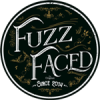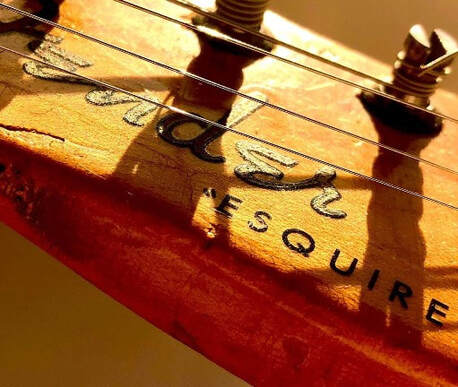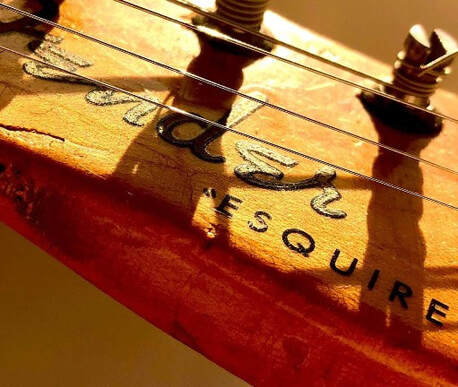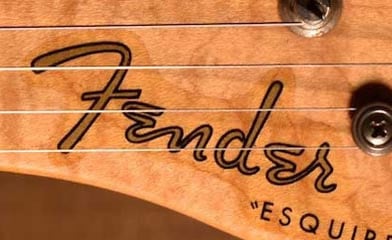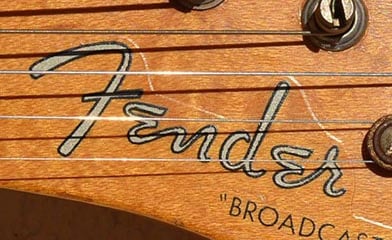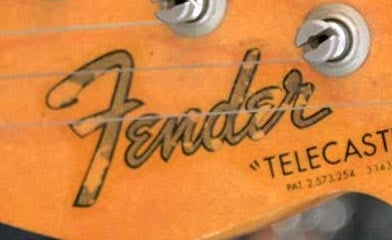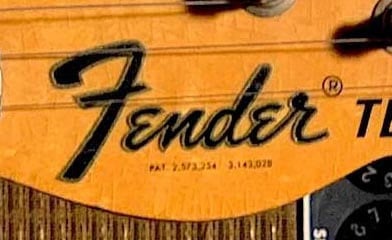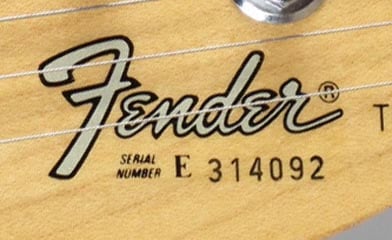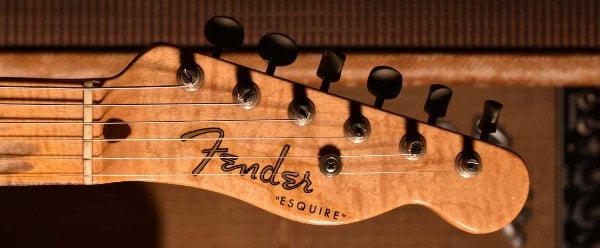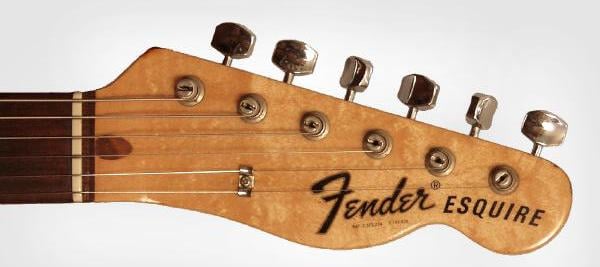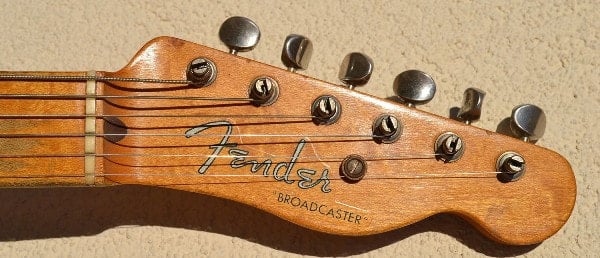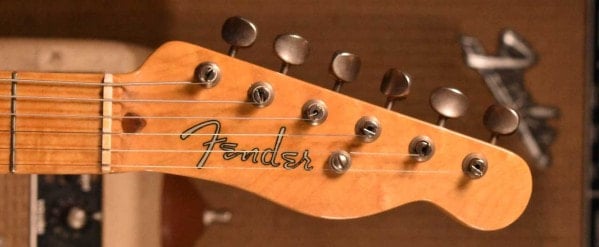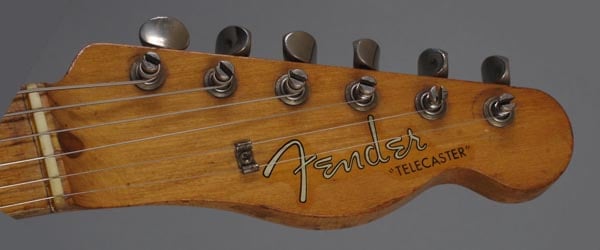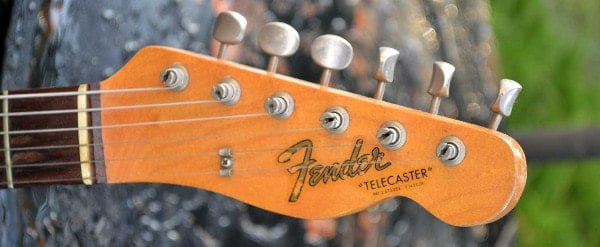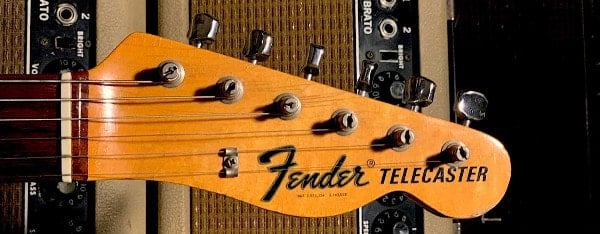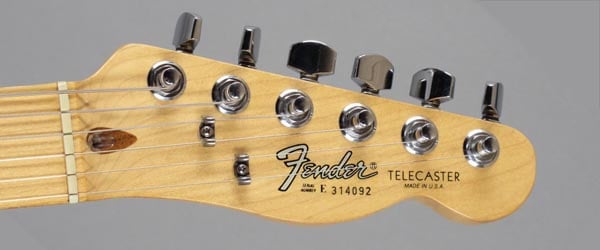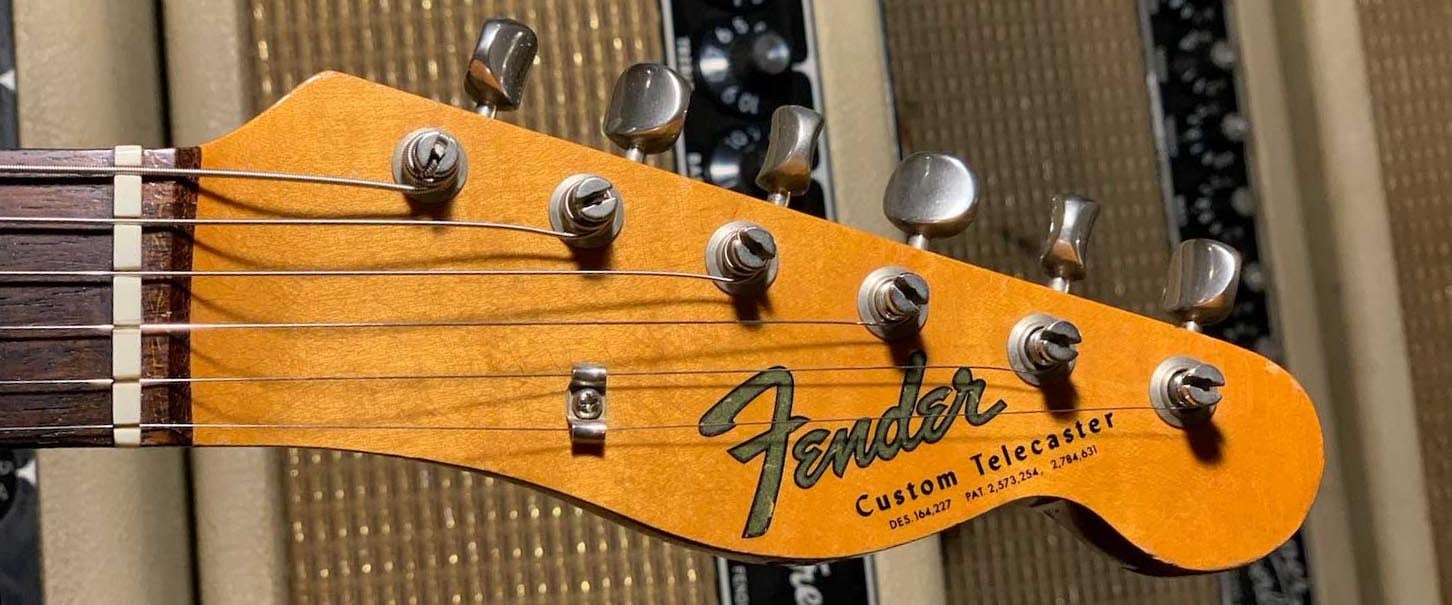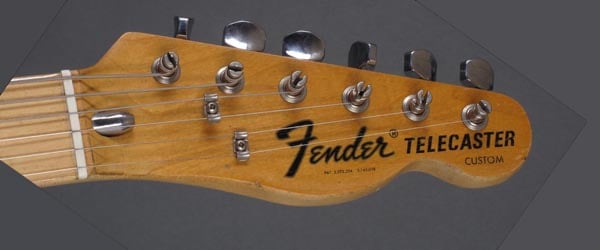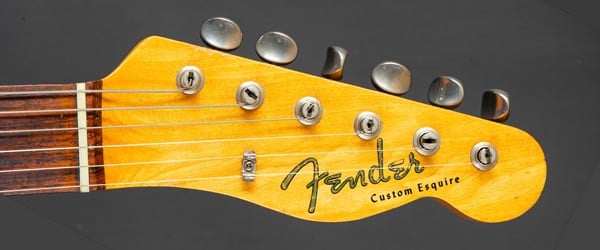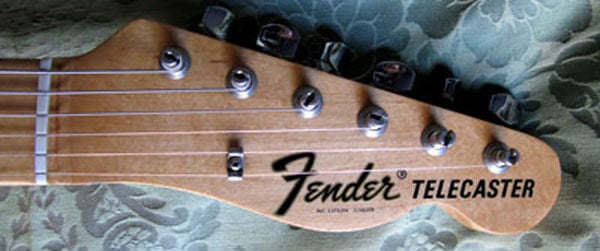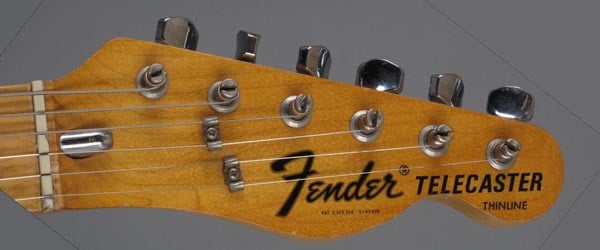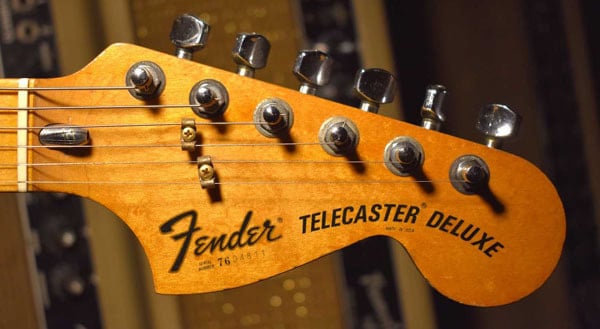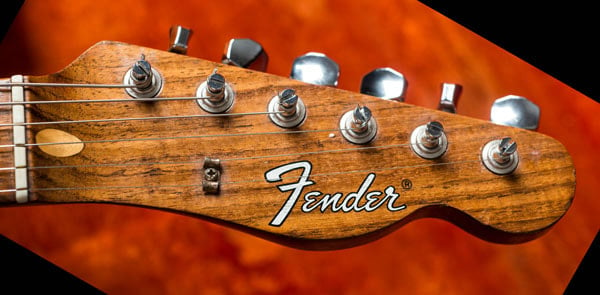|
The first Esquire prototype had a snakehead headstock with three Kluson tuning keys on each side, just like lap steel guitars. By contrast, the headstock on the second prototype was as we know it nowadays, slender and elegant, with all the machine heads on the same side. Thanks to this design the strings ran straight from the fretboard nut to the machine heads, allowing the instrument to hold the tuning better.
All Telecasters and Esquires were branded with a decal applied on the headstock, with the notable exception of the first prototypes and earliest pre-production guitars. Decals were supplied by different companies, such as Meyercord, Associated Silks Screen or Safe-T-Gal, and had a characteristic raised look. |
All the decals were water slide decals applied by letting them slide on the surface, so they never show a perfectly exact location on the headstock. The Fender logo and its assorted markings are fairly good criteria to narrow down the period of issue of a Fender guitar. However, it's important to keep in mind that changes usually happened gradually, and sometimes two types of decals overlapped.
Four main Fender logos were used:
Four main Fender logos were used:
- The thin Spaghetti Logo, silver or gold with a black trim.
- The larger Transition Logo, gold with a black trim.
- The thick Black Logo (a.k.a. TV Logo or CBS Logo), black with a gold trim.
- The slightly downsized Modern Logo (a.k.a. Whitish Logo or Silver Logo), silver with a black trim.
Up to 1956 the logo was positioned between the nut and the string retainer next to the G-string tuning post.
At the beginning of 1956, when the string tree was relocated closer to the nut, next to the A-string tuning post, the logo was moved near the upper bout of the headstock.
Until 1968 the headstock decal was always applied over the finishing lacquer.
In the late '60s, when Fender started to use polyester finishes, the decals were applied before the clear coat and thus sealed under it, providing a more durable branding. A new type of reverse decal, known as “C transfer”, which required a special solvent for its application, was used.
However, it is possible to find the Transition Logo both protected by the clear coat, and almost unchanged over time, and applied over. This type of logo had unprotected metallic pigments, which oxidized over time becoming dark green, until they detached themselves from the subtle decal.
With the advent of the Black Logo, a small circled “R” has always been featured right behind Fender on the headstock decal.
Various patent numbers were also added on the headstock under the model's name:
At the beginning of 1956, when the string tree was relocated closer to the nut, next to the A-string tuning post, the logo was moved near the upper bout of the headstock.
Until 1968 the headstock decal was always applied over the finishing lacquer.
In the late '60s, when Fender started to use polyester finishes, the decals were applied before the clear coat and thus sealed under it, providing a more durable branding. A new type of reverse decal, known as “C transfer”, which required a special solvent for its application, was used.
However, it is possible to find the Transition Logo both protected by the clear coat, and almost unchanged over time, and applied over. This type of logo had unprotected metallic pigments, which oxidized over time becoming dark green, until they detached themselves from the subtle decal.
With the advent of the Black Logo, a small circled “R” has always been featured right behind Fender on the headstock decal.
Various patent numbers were also added on the headstock under the model's name:
- DES 164,227 (New, original, and ornamental Design for a Guitar)
- PAT. 2,573,254 (Telecaster Bridge, with three saddles, and Pickup Base-Plate)
- PAT. 2,784,631 (Tone Control for Electric Guitar; Shown on a Telecaster, but never put into production on any model)
- PAT. 3,143,028 (Adjustable Neck with Curved Rosewood Fingerboard)
PRE-PRODUCTION SINGLE/DUAL PICKUP ESQUIRE
- The very first pre-production guitars didn't have any decal on the headstock face.
- Single and Dual Pickup Esquire made during Summer of 1950 featured both silver and gold Spaghetti logo with the name "ESQUIRE" in thin black lettering between inverted commas.
ESQUIRE
- Full-production Esquires featured the gold Spaghetti Logo - with some silver exceptions - with the name "ESQUIRE" in thin black lettering between inverted commas until late 1953, when they changed to the silver Spaghetti Logo.
- In 1963 the decal was completed with the same three patent numbers found since late 1961 on the regular Telecaster headstock: "DES 164,227 PAT. 2,573,254 2,784,631".
- After mid-1967, the new Transition Logo appeared on the headstock, whilst patent numbers were simultaneously reduced to only: "PAT. 2,573,254 3,143,028".
- In the latter part of 1968, the CBS Black Logo and a significantly enlarged model's name were introduced, whilst the two patent numbers were relocated below the Fender logo.
BROADCASTER, NOCASTER AND TELECASTER
- The headstock of the Broadcaster initially featured the silver Spaghetti Logo and the model's name in thin black script between inverted commas.
- From late February 1951 to early September 1951, the Broadcaster name was clipped off of the decal, then applied with only the silver Spaghetti logo, as the name was already in use by Gretsch. It is estimated that Fender shipped about 480 dual pickup guitars without a name on the headstock, which later became known by collectors as “Nocaster” guitars.
- From summer 1951 to late 1965, the headstock of the Telecaster featured the silver Spaghetti Logo and the model’s name in thin black script between inverted commas.
After late 1961 three patent numbers were added to the decal under the model's name: "DES 164,227 PAT. 2,573,254 2,784,631". - From late 1965 until 1967 the new Transition Logo was used along with two patent numbers: "PAT. 2,573,254 3,143,028".
- By fall 1967, the thick Black Logo and a significantly enlarged model's name in bolder lettering were used. The two patent numbers previously mentioned were retained, but shifted below the Fender logo.
In late 1976, the serial number was moved to the headstock and the patent numbers were deleted, whilst the words “MADE IN U.S.A.” were added below the model's designation. - In mid-1983, the Modern Logo was introduced on the Standard Telecaster, and the old smaller black lettering for the model's designation was used again (not between inverted commas). This logo was also used on the American Standard Telecaster, officially introduced at the January 1988 Winter NAMM.
TELECASTER CUSTOM
- The Telecaster Custom initially displayed a decal with the gold Spaghetti Logo, whilst the model’s designation actually reads “CUSTOM TELECASTER” (and not “TELECASTER CUSTOM”) with a slightly bolder script — albeit not as tall than the lettering on the regular Telecaster. Besides, it was not set between inverted commas.
It should be borne in mind that the very first Custom models made in mid-1959 may be found with a regular Telecaster decal without any “Custom” mention. - In mid-1964, the new Transition Logo appeared along with the three patent numbers used in the same period on the regular Telecaster: "DES 164,227 PAT. 2,573,254 2,784,631".
However, the previous “CUSTOM TELECASTER” name and script style were still kept on the headstock, but the word “CUSTOM” was deleted since late-1967. - In the course of 1968, the Black Logo and an enlarged model's name in bolder lettering was gradually applied, whilst patent numbers were simultaneously reduced to only: "PAT. 2,573,254 3,143,028".
- After mid-1972, the Custom Telecaster was a totally different guitar with a Fender Wide Range humbucking pickup in the neck position. The Black Logo with two patent numbers and enlarged Telecaster name were kept, but a “CUSTOM” label in thin black lettering was added below the model's name.
- In late 1976, the serial number was moved to the headstock and the patent numbers were deleted, whilst the Custom label was redesigned to feature a bolder script and the words “MADE IN U.S.A.” were added below the model's designation.
ESQUIRE CUSTOM
- The very first Esquire Custom models from mid-1959 may be found with a regular Esquire decal featuring a silver Spaghetti Logo without any “Custom” mention. Most 1959 guitars, though, displayed a specific decal with a gold Spaghetti Logo and “CUSTOM ESQUIRE” (and not “ESQUIRE CUSTOM”) in slightly bolder black lettering without inverted commas.
- During the late '60s, Fender replaced the previous decals with the Black Logo, a bigger Esquire script and two patent numbers: "PAT. 2,573,254 3,143,028".
TELECASTER THINLINE
- The headstock of the Telecaster Thinline featured the same decals as the regular model of the same period - Black Logo, enlarged Telecaster script and two patent numbers - but no specific “Thinline” marking on the headstock.
- In late 1971 the guitar was revamped with humbucking pickups, and a “THINLINE” script in black lettering was added under the model's name.
- In late 1976, the serial number was moved to the headstock and the patent numbers were deleted, whilst the words “MADE IN U.S.A.” were added below the model's designation.
TELECASTER DELUXE
- The Telecaster Deluxe headstock had the same shape of that of the Stratocaster and was always fitted with the same decal featuring the Black Logo with the term "TELECASTER DELUXE" in bold black letters as per a curved line. Patent numbers were never mentioned on this model.
- In late 1976, the serial number was moved to the headstock and the words “MADE IN U.S.A.” were added below the model's designation.
ROSEWOOD TELECASTER
- The Rosewood Telecaster simply featured a silverish Modern Logo with a black trim, devoid of any model designation or patent numbers.
